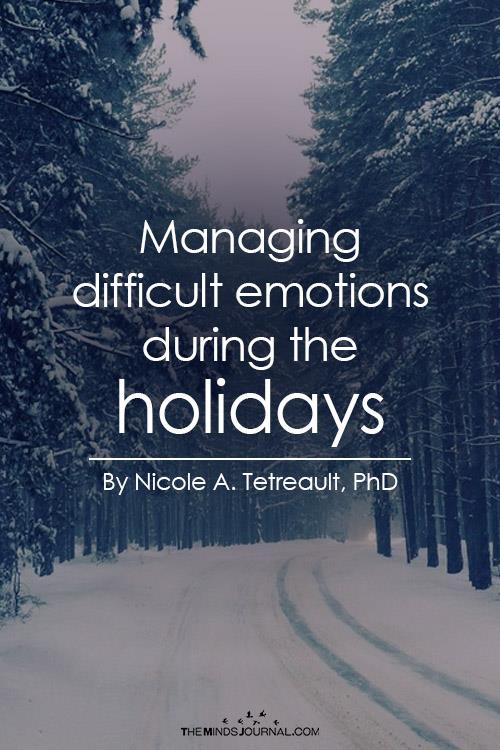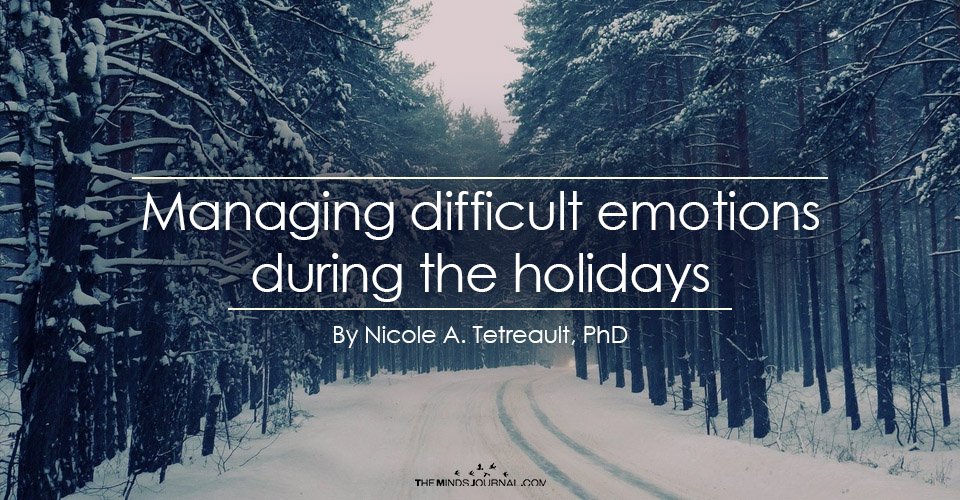Managing difficult emotions
I recently encountered two tragic events on the same day during Thanksgiving week, which made celebrating difficult. We are human and during the holiday season, we can get wrapped up in expectation of holiday cheer. We forget that life actually happens where there are moments of good, bad, beautiful, and ugly. When a tragedy strikes during the holidays, it is as if we are sucker-punched. We spiral into a deep sadness, while the rest of the world seems to celebrate. Holiday cheer can be overwhelming. The Happy Holidays signs posted in town centers, continuous playing of celebration music, glistening neighborhood lights, and marketing of “the happiest time of the year” can lead us feeling a great void. Life is messy. When we think we are traveling on the happy train to wonderland an event can derail us into an unexpected course of disappointment, sadness, and suffering.
Read How To Fully Release Difficult Emotions That Hold You Back
I learned an equation in a mindfulness-based stress reduction class that transformed my relationship with suffering. It is Suffering = Pain x Resistance. The equation brought forth my patterns and habits of holding onto suffering. Where has this equation been all my life? Pain in life is inevitable. All humans experience pain. It may be physical, as simple as stubbing our toe, or emotional pain of loss, abuse, oppression, injustice, violence, voicelessness, and powerlessness. Emotional pain and physical pain activate the same brain regions, insular cortex and anterior cingulate cortex, buried in the frontal lobe. When we feel pain, regardless of the source, it has the same neural pathway in our brain. The neural pathway has evolved for our protection from danger. What we do with the information matters in how we can access our higher wisdom and learn to acknowledge and live with the pain.
Our resistance to pain directly affects our suffering. The more we resist, according to the equation, the greater we suffer. When we loosen our resistance to pain our actual suffering decreases. For example, say we have a negative emotion like anger or sadness and we force ourselves to repress it. What happens to our physical, mental, and emotional body? The emotion is carried in our thoughts, body, and in our minds. Repressing an emotion does not make it go away. We carry an underlying feeling of anger or sadness in all that we do. Repressing the emotion may cause us to act in ways that are not authentic to our true being. Now, what happens if we acknowledge our anger or sadness and say, YES, I acknowledge my anger, sadness, fear? We gain insight and tune into our being. Even though the emotion may remain, our relationship to the emotion changes. We begin to discover the origin of the emotion. We gain knowledge about the source of the pain. When we define the source of our emotion, we can release our resistance. We can work with our resistance to lessen its grip and release into what actually is by acknowledging our pain, emotions, and fears. This in turn frees us of the burden of suffering by identifying our human limits. A moment of grace and humility arises for what actually is.
If you are dealing with challenging emotions and the holidays are difficult for you, please reach out for support. One of the major culprits of suffering is isolation. When you connect with others, gain community, and accept that pain is universal, you begin to de-identify as if you are the only one in pain. Below are a list of ways you can gain support and begin a path of healing.
1. Reach out to family and friends and share what you are experiencing. People who care for you want to support you and lift you. When you share your pain with others, you give them a chance to embrace and care for you.
2. Find a support group for your specific challenges and needs. When you understand that other people encounter painful experiences, emotions, and situations in all walks of life, this aids you in not feeling alone. Here are websites for national support groups. http://www.mentalhealthamerica.net/find-support-groups http://www.pbs.org/inthebalance/archives/whocares/resources.html
3. Seek support from a professional. Talk therapy is proven to be one of the best therapies for depression, anxiety, trauma, and mood disorders. Here is more information from the National Institute of Mental Health (NIMH) to find the best approach for you. https://www.nimh.nih.gov/health/topics/psychotherapies/index.shtml
4. Practice a loving kindness meditation to cultivate your self compassion.
Here are the list of benefits when you practice loving kindness meditation.
5. Write about your pain. Studies show that writing about your pain has been proven to aid in healing and reduce suffering.
6. If you are alone and there is no one you can reach, connect with a crisis hotline. https://suicidepreventionlifeline.org
7. If you are supporting others through a challenging time and need advice on the right words, join the option B support group.
For you,
I wish you peace.
I wish you healing.
I wish you release of your suffering.
I wish you balance.
I wish you love during the holiday season and always.
References:
Stuckey HL, Nobel J. The Connection Between Art, Healing, and Public Health: A Review of Current Literature. American Journal of Public Health. 2010;100(2):254-263. doi:10.2105/AJPH.2008.156497.








Leave a Reply